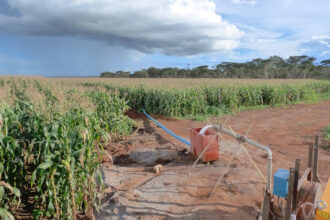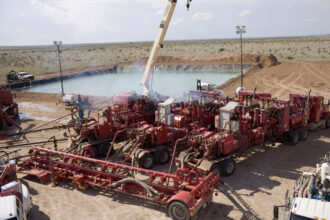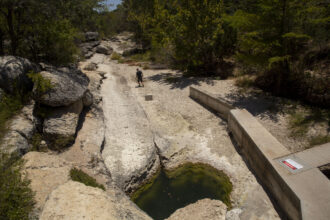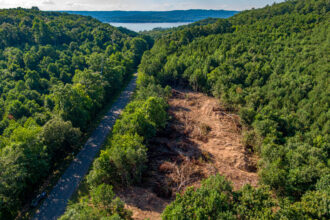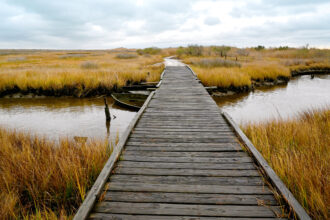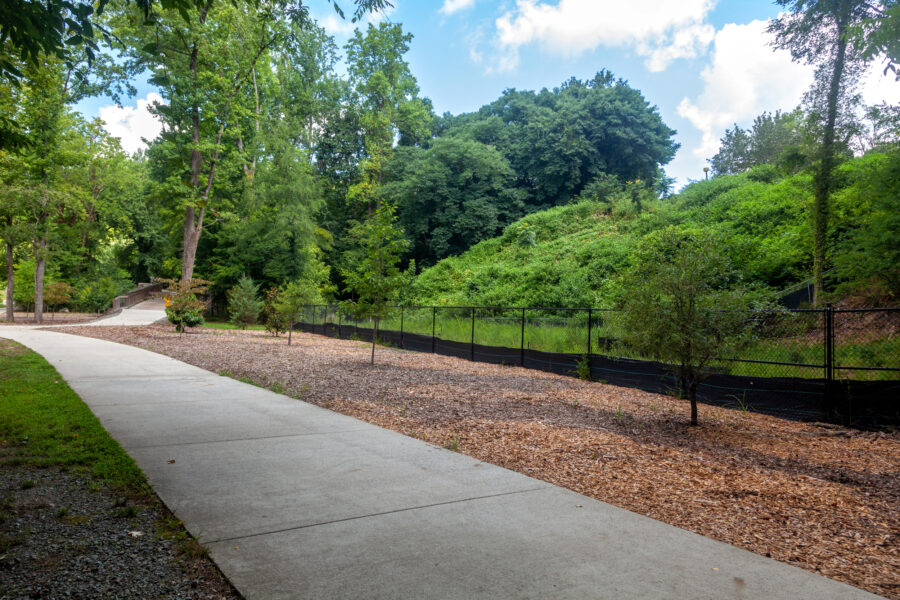TWIN FALLS, Idaho—Along the banks of the Snake River, below the Magic Valley’s fields of barley, wheat and corn, groundwater from a massive aquifer springs from steep, dark rock and crashes down the cliff to the river.
As the river runs from its headwaters near Yellowstone, springs like these add water from the massive Eastern Snake Plain Aquifer. Jay Barlogi, the general manager of the Twin Falls Canal Company, keeps a close watch on exactly how much, and he’s noticed less water flowing from the springs into the river.
Barlogi oversees a vast project that opened in 1905, established under the Carey Act, an 1894 law to settle desert lands in the West. The law gave away federal land to incentivize states and private companies to build water infrastructure. Across more than 1,000 miles of canals and ditches, the company sends water to about 5,000 users and 200,000 acres of farmland.
“Things went really, really well until all of a sudden all those pumps started going in,” he said. “Now they pump that aquifer to the point where we struggle to make it through every year.”
Since the 1940s, farmers upstream have drilled more and more wells to pump groundwater out of the aquifer that feeds the Snake River. More groundwater pumping has meant declines in springflow, less water going to the river and shortfalls for users like the canal company.
Although the issue reached a crescendo this year, “all of this chaos that’s been going on now has been going on for 20-30 years,” said Barlogi, who has worked at the canal company for more than three decades, first as a ditch rider overseeing when and how much water flowed in the channels.
For most of that time, surface water users like the canal company, dependent on their share of the Snake River, and groundwater users pumping from the Snake Plain aquifer, have argued over how to share water in a system where the two sources are connected.

The standoff reached a new peak this year, when state water officials cut off groundwater to about 500,000 acres of farmland, roughly a quarter of all irrigated land in southeastern Idaho. By mid-June, the state was tying red curtailment notices to pumps in groundwater districts that were out of compliance with a 2016 mitigation plan to manage the river and aquifer as one.
The plan aimed to offset shortfalls to the canal company and stabilize the aquifer’s decline with requirements to reduce use. If groundwater districts complied with the measures, they would be shielded from a state-mandated curtailment.
But with irrigators recovering from consecutive drought years, and various stakeholders disputing how to interpret the plan, several districts stopped complying with it. What resulted was the curtailment order, which posed an existential threat to farmers who had already invested in seed and fertilizer for the season.
“You would have been looking at at least $1,500 an acre of losses, and when you multiply that out by how many acres we have, it would have been several million dollars of loss,” said Adam Young, a third-generation barley, wheat and alfalfa farmer who uses groundwater to irrigate about 2,700 acres near Blackfoot, Idaho. “It would have been the end of our farm, frankly.
“To say we are ending our season now is to say we’re done farming permanently,” he added.

On social media, the state’s action created an uproar and generated misinformation, including a conspiracy theory about a distant, Australian-owned mine for cobalt, an element critical to the renewable energy transition, getting some of the area’s water. The lieutenant governor got involved to mediate between the two sides. On June 13, the state paused enforcement of the curtailment order, and days later, groundwater and river users negotiated a short-term agreement. That temporary deal returns to the 2016 mitigation plan and lays out a timeline for negotiating a long-term plan.
But without a permanent deal in place, everyone could be facing the same situation next year.
Farmers need to broker a long-term agreement as Idaho grapples with an issue that is facing other Western states whose water sources are threatened by overuse and a changing climate: how to apply the West’s legal framework for managing water rights—blind to economics and politics—to the physical realities about how water moves from underground to surface flows.
“The impact that declining aquifers has on river flows and senior surface water rights is going to become one of the major issues that Western states have to grapple with in the 21st century,” said Brian Patton, the deputy director of the Idaho Department of Water Resources.
Local economies and operations that have come to rely on a more ample water supply than is available are increasingly finding themselves on the brink of collapse. When there are shortfalls for the canal company, then “we start scrambling trying to figure out how we’re going to finish crops,” said Casey Williams, who uses sprinklers and gravity-fed ditches to water land his family has lived on for about 100 years.
Snake River users like Williams and groundwater irrigators like Young operate within the legacy of rules made over the past century to manage water in the arid West, where states usually allocate water on a first-come, first-served basis. In Idaho, such rules are in the state constitution. Those who claimed a right to use water first get priority to their full share, so long as they are putting it to beneficial use.
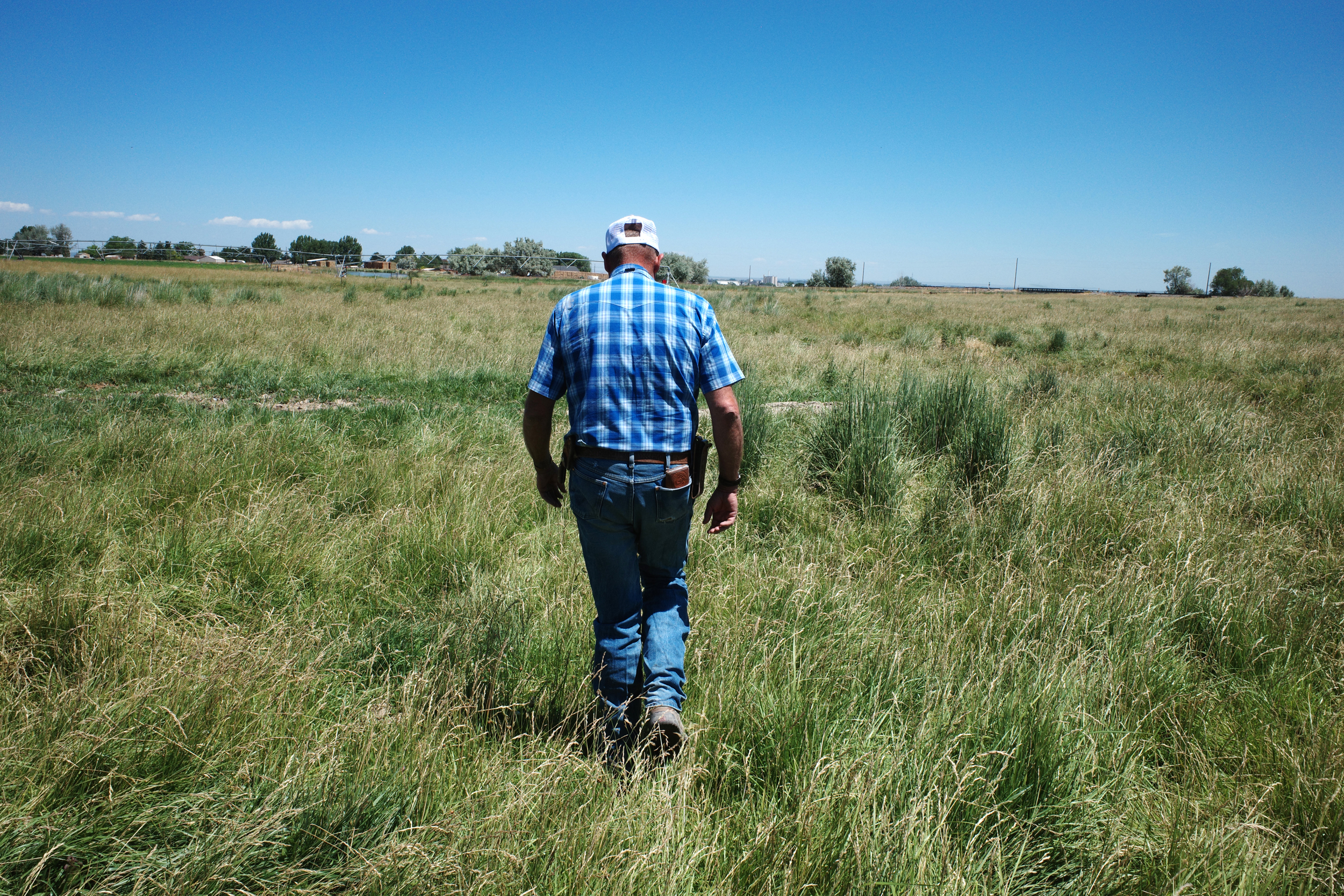
In most places, including on the Eastern Snake Plain, irrigators used surface water first. It was not until decades later, in the 1940s, that groundwater became an increasingly popular option as power costs came down and drilling technology improved. With encouragement from politicians and state officials, the alternative water supply brought more farmland into production.
For years, Western states like Idaho managed groundwater separately from the springs and rivers that aquifers fed, even as pumping lowered the water table and contributed to shortfalls for surface water users who had claimed water first. Some states, such as Nevada, are just now starting to contend with managing surface water and groundwater as a connected source.
But in Idaho, this began to change in the 1990s when the Surface Water Coalition, which includes the canal company and other users with older water rights with higher priority, made a formal filing, known as a “call on the river,” to request their full water allotment. Doing that meant curtailing groundwater users with newer rights and a lower priority.
The move led to a flurry of conflict and litigation that ultimately ended in the state managing the Snake River and its connected aquifer in conjunction with one another. Over time, water users negotiated mitigation plans requiring groundwater users to stabilize the aquifer and offset the shortfall to canal companies by leasing water stored in reservoirs and sending it downstream.
This story is funded by readers like you.
Our nonprofit newsroom provides award-winning climate coverage free of charge and advertising. We rely on donations from readers like you to keep going. Please donate now to support our work.
Donate NowThe plan worked for years, but things started to break down in the dry years of 2021 and 2022, when irrigators across the Snake River Basin were struggling to maintain their crops. “It was hot all summer long,” said Alan Jackson, who leads the Bingham Groundwater District, where Young is on the board. “The irrigation requirement was really high.”
The Surface Water Coalition alleged that several groundwater districts fell short of the yearly reductions required by the mitigation agreement. The districts pushed back, arguing that they should be credited for reducing use in excess of the requirement during wet years. The dispute culminated with the state finding that certain groundwater districts deviated from the mitigation plan and were subject to a curtailment order, which was issued on May 30.
“We’re heavily dependent on agriculture in Bingham County,” Jackson said. “The loss of 70 percent of our agriculture—it would have been a ghost town. It would have absolutely been devastating.”
But the law as written and interpreted by the courts is clear, Patton said. The allocation to those with “senior” rights to divert water from the Snake River get priority over groundwater users. If pumping lowers springs and cuts their supply, groundwater users have to reduce their use through a mitigation plan or face cuts imposed by the state.

The curtailment last spring sparked an outcry, media attention and a quick settlement, but it did not offer a permanent solution. Instead, the short-term deal required everyone to go back to the negotiating table to try to develop a new mitigation plan by October. Everyone “learned that the way Idaho has been doing it is not in the best interest of the state as a whole and the water users,” said TJ Budge, an attorney who represents a coalition of groundwater districts.
The current negotiations center on how to manage the system in a way that staunches its decline and gets more water to the river, but also builds in enough flexibility to get through dry years. In addition to reducing groundwater use, some ideas include expanding aquifer recharge by allowing more water to flow back underground during wet years, improving efficiency in canal systems, for instance by lining canals to make them less leaky and working to better model the aquifer.
Sitting on the porch of the house where he grew up and is raising his kids, Young said that he wants to see his farm and the aquifer continue to thrive for hundreds of years. “I hate the idea that we’re going to lose what we have because we’re being foolish with our resources,” he said.
Bingham County, where he lives, is home to the Idaho Potato Museum, where visitors take pictures in front of a baked potato sculpture. One of the first exhibits in the museum touts the aquifer as among the “largest and most productive” on Earth. And despite the chaos and conflict over the curtailment, Young said he sees paths to keeping it that way. “Here in Idaho, we’re a headwater state,” he said. “We’ve got all kinds of opportunities to invest in things to improve our situation.”
State officials want the groups to reach a new deal, too. Issuing the curtailment weighed heavily on them “because you’re impacting people’s livelihoods, you’re impacting people’s operations,” Patton said. In some areas, you are not only cutting the water to farmers but also other businesses served by groundwater districts, like processing plants for agricultural products.
“But the law is also extremely clear,” he said.
About This Story
Perhaps you noticed: This story, like all the news we publish, is free to read. That’s because Inside Climate News is a 501c3 nonprofit organization. We do not charge a subscription fee, lock our news behind a paywall, or clutter our website with ads. We make our news on climate and the environment freely available to you and anyone who wants it.
That’s not all. We also share our news for free with scores of other media organizations around the country. Many of them can’t afford to do environmental journalism of their own. We’ve built bureaus from coast to coast to report local stories, collaborate with local newsrooms and co-publish articles so that this vital work is shared as widely as possible.
Two of us launched ICN in 2007. Six years later we earned a Pulitzer Prize for National Reporting, and now we run the oldest and largest dedicated climate newsroom in the nation. We tell the story in all its complexity. We hold polluters accountable. We expose environmental injustice. We debunk misinformation. We scrutinize solutions and inspire action.
Donations from readers like you fund every aspect of what we do. If you don’t already, will you support our ongoing work, our reporting on the biggest crisis facing our planet, and help us reach even more readers in more places?
Please take a moment to make a tax-deductible donation. Every one of them makes a difference.
Thank you,





